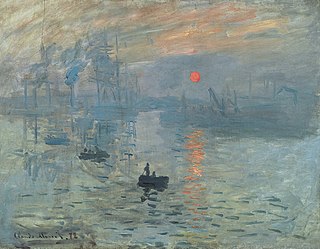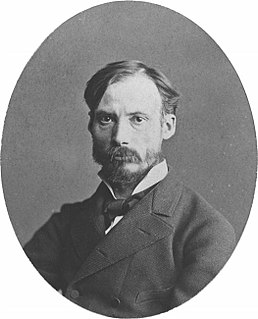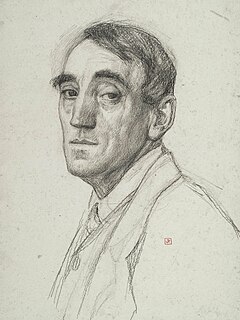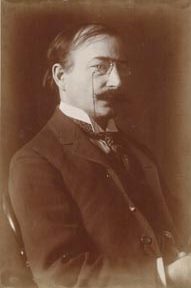

Paul Vogler (8 March 1853, Paris - 17 December 1904, Verneuil-sur-Seine) [1] was a French painter in the Impressionist style, known mostly for his landscapes.


Paul Vogler (8 March 1853, Paris - 17 December 1904, Verneuil-sur-Seine) [1] was a French painter in the Impressionist style, known mostly for his landscapes.
He was initially self-taught and did decorative work. Later, he was able to polish his technique when Alfred Sisley met him, became his mentor, [2] and had a major influence on his style. He mostly painted landscapes in Le Midi, Brittany, Oise and the rural areas around Paris, at different seasons and times of day, to capture variations in the effects of light. [3]
Thanks to his advice and urgings, Le Barc de Boutteville, dealers in classic art, became interested in contemporary painters and began offering their works in 1891. [2] In 1893, commissioned by the poet, Tola Dorian , he painted the sets for Pelléas et Mélisande by Maurice Maeterlinck, in a production by Lugné-Poe [3] In 1899, he had his largest exhibit at the gallery of Ambroise Vollard.
Despite his success, he was apparently rather profligate and died in poverty.

One of his works, "Alley Near a Small Town", was mistakenly attributed to Sisley because of a forged signature. The original signature was discovered in 2016, during a restoration at the Kunsthalle Bremen. [4] The painting had been in the possession of Pastor Johann Friedrich Lahmann (1858-1937) and was donated to the museum when he died. Suspicion was aroused when it was noted that the painting was not listed in Sisley's catalogue raisonné.

Impressionism was a 19th-century art movement characterized by relatively small, thin, yet visible brush strokes, open composition, emphasis on accurate depiction of light in its changing qualities, ordinary subject matter, unusual visual angles, and inclusion of movement as a crucial element of human perception and experience. Impressionism originated with a group of Paris-based artists whose independent exhibitions brought them to prominence during the 1870s and 1880s.

Pierre-Auguste Renoir was a French artist who was a leading painter in the development of the Impressionist style. As a celebrator of beauty and especially feminine sensuality, it has been said that "Renoir is the final representative of a tradition which runs directly from Rubens to Watteau."

Alfred Sisley was an Impressionist landscape painter who was born and spent most of his life in France, but retained British citizenship. He was the most consistent of the Impressionists in his dedication to painting landscape en plein air. He deviated into figure painting only rarely and, unlike Renoir and Pissarro, found that Impressionism fulfilled his artistic needs.

The Barbizon school of painters were part of an art movement towards Realism in art, which arose in the context of the dominant Romantic Movement of the time. The Barbizon school was active roughly from 1830 through 1870. It takes its name from the village of Barbizon, France, on the edge of the Forest of Fontainebleau, where many of the artists gathered. Most of their works were landscape painting, but several of them also painted landscapes with farmworkers, and genre scenes of village life. Some of the most prominent features of this school are its tonal qualities, color, loose brushwork, and softness of form.

Théophile "Théo" van Rysselberghe was a Belgian neo-impressionist painter, who played a pivotal role in the European art scene at the turn of the twentieth century.
The art gallery of Le Barc de Boutteville, at 47 Rue Le Peletier, 9th arrondissement, was one of the few places in Paris in the 1890s where young artists were welcome to present their work to the public, in the years after the death of Theo van Gogh and before Ambroise Vollard opened his gallery.

Georges-Émile Lebacq was a Belgian painter.

Adolphe Étienne Auguste Moreau-Nélaton was a French painter, art collector and art historian. His large collection is today held in its entirety by French national museums.

Maxime Maufra was a French landscape and marine painter, etcher and lithographer.

Léon Printemps was a French artist known best for his work as a portrait and landscape painter.

Robert Antoine Pinchon was a French Post-Impressionist landscape painter of the Rouen School who was born and spent most of his life in France. He was consistent throughout his career in his dedication to painting landscapes en plein air. From the age of nineteen he worked in a Fauve style but never deviated into Cubism, and, unlike others, never found that Post-Impressionism did not fulfill his artistic needs. Claude Monet referred to him as "a surprising touch in the service of a surprising eye".

Albert Lebourg, birth name Albert-Marie Lebourg, also called Albert-Charles Lebourg and Charles Albert Lebourg, was a French Impressionist and Post-Impressionist landscape painter of the Rouen School. Member of the Société des Artistes Français, he actively worked in a luminous Impressionist style, creating more than 2,000 landscapes during his lifetime. The artist was represented by Galerie Mancini in Paris in 1896, in 1899 and 1910 by : Galerie Bernheim-Jeune, 1903 and 1906 at the Galerie Paul Rosenberg, and 1918 and 1923 at Galerie Georges Petit.

Frédéric Samuel Cordey (1854–1911) was a French landscape painter who was a part of the Impressionist movement. He was a close friend of Auguste Renoir, and had a personal fortune that allowed him to work according to his taste, regardless of the publicity and support provided by art dealers.

Auguste Bonheur was a French painter of animals and bucolic scenes in landscapes. In his compositions he was able to accurately depict the horizon, ambience, luminous settings and space. His works show the influence of the paintings of cattle by seventeenth-century Dutch painters such as Aelbert Cuyp and Paulus Potter.

Jean-Baptiste-Antoine Guillemet was a French renowned landscape painter and longtime Jury member of the Salon des Artistes Francais. He was one of the first 19th-century artists to paint modern life, and a pivotal figure in the transition from Realism to Impressionism.

Henri Beau was a French-Canadian Impressionist painter. He is noted for Chemin en été, La dispersion des Acadiens, L'arrivée de Champlain à Québec, and Les Noces de Cana. Beau is a largely forgotten artist due to his long absence from Canada. His widow Marie Beau worked towards establishing his reputation as an artist in Canada after his death. He was only recognized as a notable artist decades later, with major retrospectives of his paintings celebrating his career by the Galerie Bernard Desroches in Montréal in 1974, and at the Musée du Québec in Québec City in 1987.

Auguste-Xavier Leprince was a French artist and painter who attained celebrity at the age of seventeen. His patrons included the Duchesse de Berry, Charles X, and Alexandre du Sommerard. He was also a teacher; in his twenties he established his own atelier in Paris, with pupils including his two younger brothers, Robert-Léopold and Pierre-Gustave, as well as Eugène Lepoittevin and Nicolas Alexandre Barbier. His meteoric career came to an abrupt end and his "brilliant promise was cut short by his premature death at the age of twenty-seven."

Pierre Prins was a French painter, engraver and sculptor.

The Aqueduct at Marly is an 1874 painting by Alfred Sisley. It was bought from the artist by Paul Durand-Ruel in 1876 before being acquired by Edward Libbey, who in turn donated it to the Toledo Museum of Art, where it now hangs. It shows the Aqueduc de Louveciennes. A lifesize reproduction of it is sited at the site of its creation as part of the Pays des Impressionnistes scheme.

View of Auvers-sur-Oise is the common English name for a Paul Cézanne painting known by various French names, usually Paysage d'Auvers-sur-Oise, or in the artist's catalogue raisonné, Groupe de maisons, paysage d'île de France. It is believed to have been painted in 1879–80, several years after Cézanne's residence in Auvers-sur-Oise, a small village northwest of Paris. The painting depicts a landscape of Northern France; the exact location has not been determined.